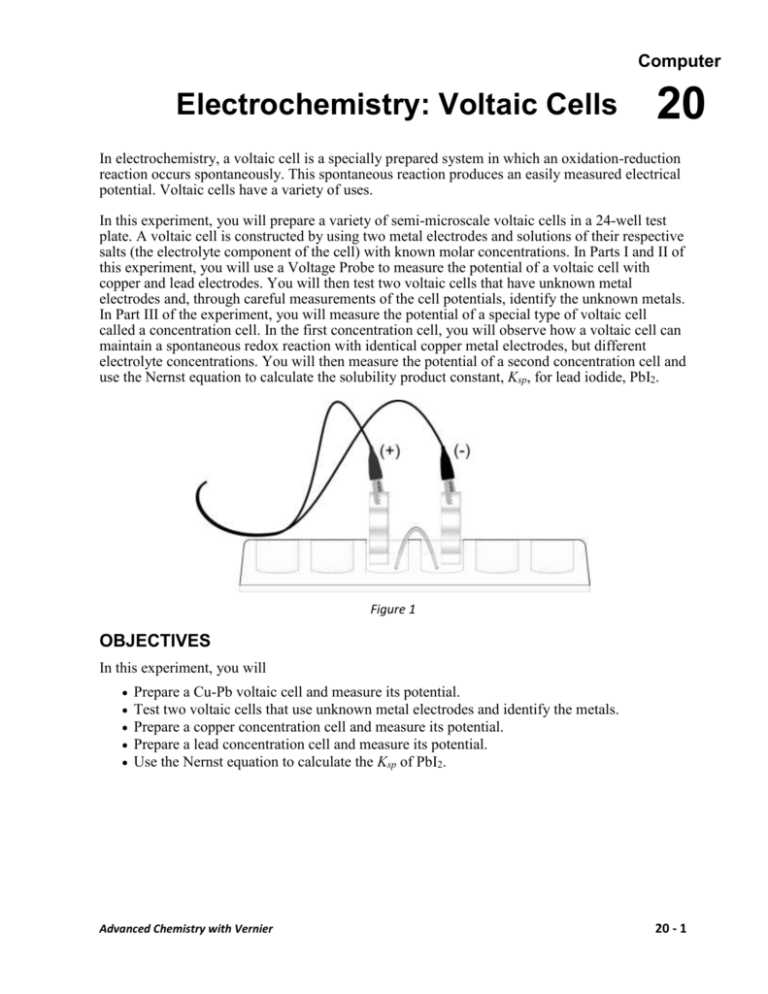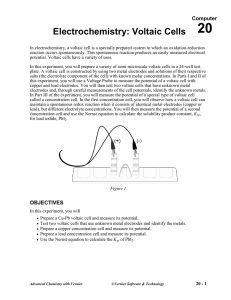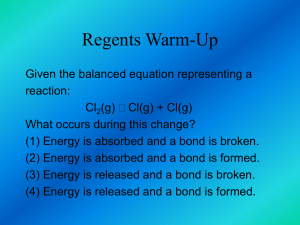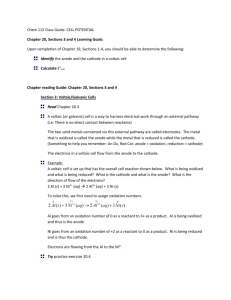Electrochemistry: Voltaic Cells
advertisement

Computer Electrochemistry: Voltaic Cells 20 In electrochemistry, a voltaic cell is a specially prepared system in which an oxidation-reduction reaction occurs spontaneously. This spontaneous reaction produces an easily measured electrical potential. Voltaic cells have a variety of uses. In this experiment, you will prepare a variety of semi-microscale voltaic cells in a 24-well test plate. A voltaic cell is constructed by using two metal electrodes and solutions of their respective salts (the electrolyte component of the cell) with known molar concentrations. In Parts I and II of this experiment, you will use a Voltage Probe to measure the potential of a voltaic cell with copper and lead electrodes. You will then test two voltaic cells that have unknown metal electrodes and, through careful measurements of the cell potentials, identify the unknown metals. In Part III of the experiment, you will measure the potential of a special type of voltaic cell called a concentration cell. In the first concentration cell, you will observe how a voltaic cell can maintain a spontaneous redox reaction with identical copper metal electrodes, but different electrolyte concentrations. You will then measure the potential of a second concentration cell and use the Nernst equation to calculate the solubility product constant, Ksp, for lead iodide, PbI2. Figure 1 OBJECTIVES In this experiment, you will Prepare a Cu-Pb voltaic cell and measure its potential. Test two voltaic cells that use unknown metal electrodes and identify the metals. Prepare a copper concentration cell and measure its potential. Prepare a lead concentration cell and measure its potential. Use the Nernst equation to calculate the Ksp of PbI2. Advanced Chemistry with Vernier 20 - 1 Computer 20 MATERIALS Vernier computer interface 0.10 M copper (II) nitrate, Cu(NO3)2, solution computer 0.10 M lead (II) nitrate, Pb(NO3)2, solution Voltage Probe 1.0 M copper (II) sulfate, CuSO4, solution three 10 mL graduated cylinders 0.050 M potassium iodide, KI, solution 24-well test plate 1 M potassium nitrate, KNO3, solution string 0.10 M X nitrate solution Cu and Pb electrodes 0.10 M Y nitrate solution two unknown electrodes, labeled X and Y steel wool 150 mL beaker plastic Beral pipets PRE-LAB EXERCISE Create a table of reagents Write a purpose for this lab Use the table of standard reduction potentials in your text, or another approved reference, to complete the following table. An example is provided. Electrodes Half-reactions E° Zn Zn(s) → Zn2+ + 2e– +0.76 V Cu Cu2+ → Cu(s) +0.34 V + 2e– E°cell +1.10 V Cu Pb Pb Ag Pb Mg Pb Zn 20 - 2 Advanced Chemistry with Vernier Electrochemistry: Voltaic Cells PROCEDURE Part I Determine the Eo for a Cu-Pb Voltaic Cell 1. Obtain and wear goggles. 2. Use a 24-well test plate as your voltaic cell. Use Beral pipets to transfer small amounts of 0.10 M Cu(NO3)2 and 0.10 M Pb(NO3)2 solution to two neighboring wells in the test plate. CAUTION: Handle these solutions with care. If a spill occurs, ask your instructor how to clean up safely. 3. Obtain one Cu and one Pb metal strip to act as electrodes. Polish each strip with steel wool. Place the Cu strip in the well of Cu(NO3)2 solution and place the Pb strip in the well of Pb(NO)3 solution. These are the half cells of your Cu-Pb voltaic cell. 4. Make a salt bridge by soaking a short length of string in a beaker than contains a small amount of 1 M KNO3 solution. Connect the Cu and Pb half cells with the string. 5. Connect a Voltage Probe to Channel 1 of the Vernier computer interface. Connect the interface to the computer with the proper cable. 6. Start the Logger Pro program on your computer. Open the file “20 Electrochemistry” from the Advanced Chemistry with Vernier folder. 7. Measure the potential of the Cu-Pb voltaic cell. Complete the steps quickly to get the best data. a. Click to start data collection. b. Connect the leads from the Voltage Probe to the Cu and Pb electrodes to get a positive potential reading. Click immediately after making the connection with the Voltage Probe. c. Remove both electrodes from the solutions. Clean and polish each electrode. d. Put the Cu and Pb electrodes back in place to set up the voltaic cell. Connect the Voltage Probe to the electrodes, as before. Click immediately after making the connection with the Voltage Probe. e. Remove the electrodes. Clean and polish each electrode again. f. Set up the voltaic cell a third, and final, time. Click immediately after making the connection with the Voltage Probe. Click to end the data collection. g. Click the Statistics button, . Record the mean in your data table as the average potential. Close the statistics box on the graph screen by clicking the X in the corner of the box. Part II Determine the Eo for Two Voltaic Cells Using Pb and Unknown Metals 8. Obtain a small amount of the unknown electrolyte solution labeled “0.10 M X” and the corresponding metal strip, X. 9. Use a Beral pipet to transfer a small amount of 0.10 M X solution to a well adjacent to the 0.10 M Pb(NO3)2 solution in the test plate. 10. Make a new salt bridge by soaking a short length of string in the beaker of 1 M KNO3 solution. Connect the X and Pb half cells with the string. 11. Measure the potential of the X-Pb voltaic cell. Complete this step quickly. a. Click to start data collection. Advanced Chemistry with Vernier 20 - 3 Computer 20 b. Connect the leads from the Voltage Probe to the X and Pb electrodes to get a positive potential reading. Click immediately after making the connection with the Voltage Probe. c. Remove both electrodes from the solutions. Clean and polish each electrode. d. Set up the voltaic cell again. Connect the Voltage Probe as before. Click immediately after making the connection with the Voltage Probe. e. Remove the electrodes. Clean and polish each electrode again. f. Test the voltaic cell a third time. Click immediately after making the connection with the Voltage Probe. g. Click to end data collection. h. Click the Statistics button, . Record the mean in your data table as the average potential and then close the statistics box on the graph screen by clicking the X in the corner of the box. 12. Repeat Steps 8–11 using the unknown and its corresponding electrolyte solution labeled “Y”. Part III Prepare and Test Two Concentration Cells 13. Set up and test a copper concentration cell. a. Prepare 20 mL of 0.050 M CuSO4 solution by mixing 1 mL of 1.0 M CuSO4 solution with 19 mL of distilled water. b. Set up a concentration cell in two wells of the 24-well test plate by adding 5 mL of 0.050 M CuSO4 solution to one well and 5 mL of 1.0 M CuSO4 solution to a neighboring well. Use Cu metal electrodes in each well. Use a KNO3-soaked string as the salt bridge, as in Parts I and II. c. Click to start data collection. d. Test and record the potential of the concentration cell in the same manner that you tested the voltaic cells in Parts I and II. 14. Set up a concentration cell to determine the solubility product constant, Ksp, of PbI2. a. Prepare 10 mL of 0.050 M Pb(NO3)2 solution by mixing 5 mL of 0.10 M Pb(NO3)2 solution with 5 mL of distilled water. b. Mix 9 mL of 0.050 M KI solution with 3 mL of 0.050 M Pb(NO3)2 solution in a small beaker. In this reaction, most of the Pb2+ and I– will form the precipitate PbI2, but a small amount of the ions will remain dissolved. c. Set up the half cells in neighboring wells of the 24-well test plate. Place 5 mL of 0.050 M Pb(NO3)2 solution in one half cell, and 5 mL of the PbI2 mixture, from the small beaker, into an adjacent half cell. Use Pb electrodes in each half cell. Use a KNO3-soaked string as the salt bridge. d. Test and record the potential of the cell in the same manner that you tested the voltaic cells and the copper concentration cell. 15. Discard the electrodes and the electrolyte solutions as directed. Rinse and clean the 24-well plate. CAUTION: Handle these solutions with care. If a spill occurs, ask your instructor how to clean up safely. 20 - 4 Advanced Chemistry with Vernier Electrochemistry: Voltaic Cells DATA TABLE Results of Parts I and II Cu/Pb X/Pb Cu concentration Pb/PbI2 Y/Pb Average cell potential (V) Results of Part III Average cell potential (V) DATA ANALYSIS 1. (Part I) Compare the average cell potential, for your Cu/Pb cell, with the E°cell that you calculated in the pre-lab exercise. Explain why your cell potential is different from the text value. 2. (Part II) The unknown metals X and Y were either magnesium, silver, or zinc. Use the text value for the reduction potential of Pb and the measured cell potentials for the unknowns to identify X and Y. 3. (Part III) Use the Nernst equation to calculate the theoretical value of E of the copper-concentration cell and compare this value with the cell potential that you measured. Advanced Chemistry with Vernier 20 - 5 Computer 20 4. (Part III) Use the Nernst equation and the information that you collected about the Pb/PbI2 cell to complete the following calculations. a. Use the cell potential for the Pb-PbI2 cell and the known [Pb2+] to calculate the [Pb2+] in equilibrium with PbI2. b. Use the original diluted [Pb2+] and [I–] to calculate the [I–] in solution. c. Use your data to calculate the Ksp of PbI2 The accepted value of the Ksp of PbI2 is 9.8 × 10–9. How does your experimental Ksp of PbI2 compare with the accepted value? EXTENSION 1. Determine the dissociation constant of Cu(NH3)42+. a. Mix 5 mL of 0.050 M CuSO4 solution with 5 mL of 3.0 M NH3 solution in a small beaker. CAUTION: Handle the NH3 solution with care. Pour 5 mL of this mixture into a well adjacent to the 0.050 M CuSO4 well that you set up in Step 13a. b. Use copper electrodes. Use a KNO3-soaked string as the salt bridge. c. Test and record the potential of the cell as before. 2. Complete the following calculations, which lead to the dissociation constant of Cu(NH3)42+. a. b. c. d. e. 20 - 6 Calculate [Cu2+] in equilibrium with Cu(NH3)42+. Use the original diluted [Cu2+] and [NH3] to calculate the [Cu(NH3)42+] that formed. Calculate the [NH3] that forms a complex with the original diluted [Cu2+]. Calculate [NH3] in equilibrium with [Cu(NH3)42+]. Calculate the value of the dissociation constant for Cu(NH3)42+ ⇌ Cu2+ + 4NH3. Compare your value to the accepted (text) value of the dissociation constant. Advanced Chemistry with Vernier









